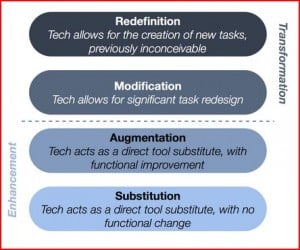ISTE 2013 Day 3
Session 1
Tech That! Extending Student’s Digital Environment into the Classroom – Robert Craven and Rushton Hurley were
a dynamic duo. My biggest takeaway was an introduction to Ruben Puentedura’s SAMR (Substitution, Augmentation, Modification, Redefinition) model for technology integration, which makes visible the transition from technology as tool for enhancing learning to technology as a tool for transforming learning.
A great tip from Robert: Give your PD workshops at sites, targeted to what teachers at that site need.
A great reminder from Rushton: When students take their work to an authentic audience, they want to know if their work is “good.” When they publish solely for their teachers, they want to know if their work is “good enough.”
A great read: New Media Verizon Report – Tips on how to pull experiences students have outside of class into class.
Session 2
Digital Citizenship: A Crosswalk from Common Core to Core Curriculum– I’m plugging my own session because any opportunity to co-present with my Digital ID co-curator Natalie Bernasconi is always an energizer and a privilege. Having Common Sense Media’s Kelly Mendoza joining us was icing on the cake. And having Mike Ribble in the audience further validated the importance of weaving digital citizenship into the core curriculum.
Session 3
Advanced Searching for Inquiry Meets the Common Core – Project-Based Learning educator Mike Gorman and a IT director Anita Harris teamed for this session.
Takeaways:
- “Search is research.”
- A Google Advanced Search should be a basic search for students. Brilliant!
- A few more search tools:
- VisuWords.com – CCSS short research – Nural net of word associations.
- Wordsift.com
- wikipedia – great starter – take it into a Wordle * great idea for finding key words
- answergarden.ch
- www.text2mindmap.com
- wolfram alpha – Find, for instance, nutritional value of a burger
- www.sweetsearch.com – Human reviewed search engine for students. Credible results – great starting point – check out biographies
- Twurdy (too wordy) – color-coded – down to age 8
- Google Custom Search – why not involve students in creating it?
- think-pair-share – Funny how this time-tested strategy works as well today as in the past – especially in PBL classrooms.
- Twitter Advanced Search – How did I not know about advanced search feature, which does not require signing into Twitter. Could be a great way to bring more educators on board with the power of Twitter.
Birds of a Feather Session: Digital Citizenship
Good news! Thanks to the vision and commitment of Mike Ribble and Jason Ohler, ISTE may soon be adding a Digital Citizenship SIG (Special Interest Group). I loved being part of this high-energy group discussion. We brainstormed the SIG’s potential goals and projects, which included providing a forum for exchanging best practices, working with teacher prep programs to ensure that teachers are well-prepared for integrating digital citizenship into the curriculum; and creating a digital citizenship massive open online course (MOOC). And we even agreed on the Twitter name: @digcitsig.
Takeaways:
Digital citizenship:
- Can’t be top down, can’t be taught in isolation, and can’t be tested; it should be crowd sourced
- None of our online programs are evidence-based – we need to empower kids – not scare them. Discussion is key! (not just lessons).
- In the time of Common Core, we need to provide digital environments to teach digital citizenship; otherwise, it’s like teaching swimming without a pool.

